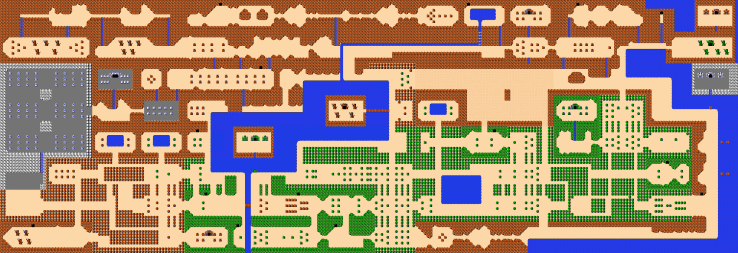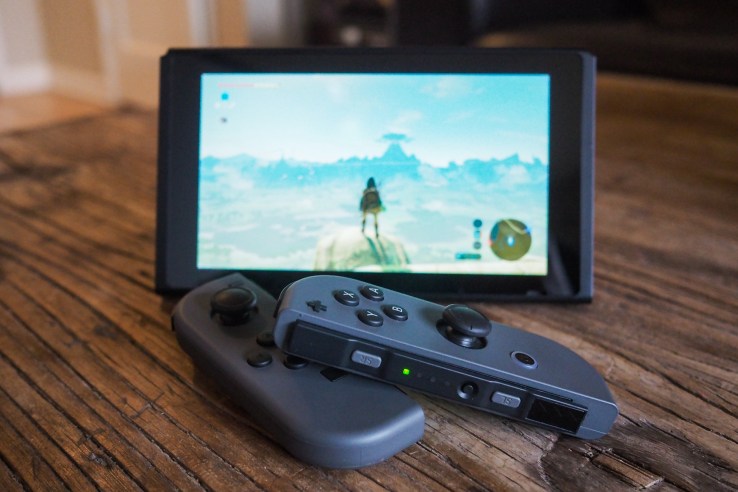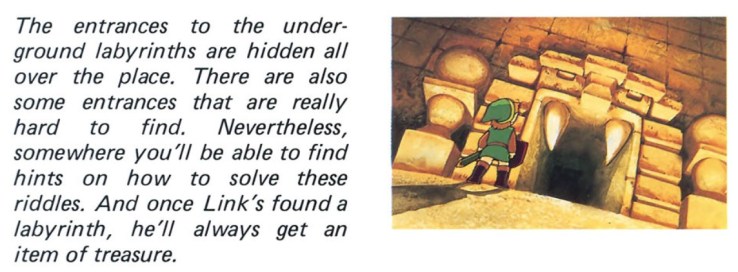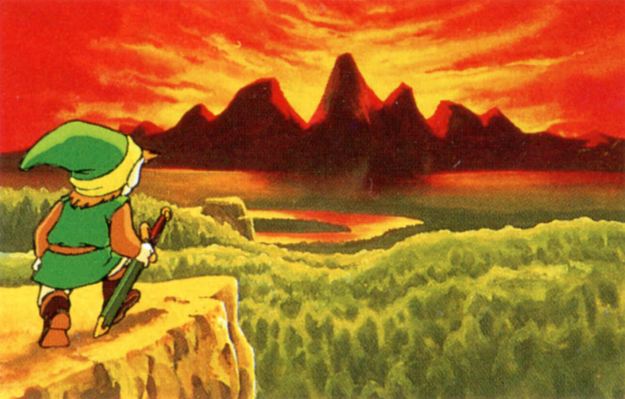Now and again in the hype period for The Legend of Zelda: Breath of the Wild, the game’s creators compared it to the original NES classic.
I chalked this up to the usual pre-release silliness; how could a brand-new game be anything like something released in 1986? It turns out I’d underestimated both Nintendo’s candor (understandable) and the timelessness of the first Zelda’s design. This leads to a strange paradox: That Breath of the Wild is so like its ancient ancestor makes it both the most Nintendo game in a long time and the least Nintendo game in a long time. Perhaps, after years of limping, the company has once more found its stride.
The similarities are striking. In both games, you begin in a rocky, forested wilderness with nothing but the clothes on your back and hardly any idea what you are to do. In a cave near your place of rebirth (in the original, it’s where you’d appear if you’d die; in BotW, it’s where you are literally reborn) you find a friendly old man by a fire who sends you on your way (he doesn’t give you a sword, but he does give you an important item later, and advises you on finding a weapon).
Armed thus in the most scanty fashion, you charge forth into the unmapped wilderness, where monsters swarm, countless secrets hide in the landscape, and a nebulously articulated quest beckons you forth from biome to biome and dungeon to dungeon.
One could say some of these things about a number of Zelda games, of course, but Breath of the Wild takes these parallels much further than any other.
 Think back, if you can, to the time you first played the original Zelda. Remember how enormous the world felt, and how every screen seemed to hold potential.
Think back, if you can, to the time you first played the original Zelda. Remember how enormous the world felt, and how every screen seemed to hold potential.
How many bombs did you waste scouring the mountains for hidden rooms? How many times did you leave and re-enter a screen to try your Blue Candle on every suspicious tree? How proud were you when your painstaking searches of the graveyard revealed (in addition to dozens of ghosts) the resting place of the Master Sword? The world was so big you could barely wrap your head around it, and the feeling of discovery and triumph whenever you proved your worth in it was real.
Yet today’s game market is full of enormous open worlds that fail to elicit similar feelings; despite high production values, they often have the feeling of dolled-up checklists.
Breath of the Wild, however, successfully conveys that feeling of inviting grandeur.
Part of that is the lack of any impelling narrative, which allows you to appreciate the world at your own pace. Oh yes, you’re the legendary hero and you need to stop Ganon. That part hasn’t changed. But the game doesn’t constrain you into a series of quests.
In the original Zelda, your starting screen has three exits. None is the correct one. It doesn’t tell you, “head north and look for the first dungeon!” You are free to wander, to encounter enemies you have no chance of beating, places and items you can’t reach and experience the controls and rules of the world for yourself, on your own time, in your own way. It’s like this again in Breath of the Wild.
Once you complete the initial handful of temples awarding you the core abilities and paraglider, you are free to go anywhere in the wide world — you’re encouraged, in fact, to just strike out in literally any direction from the central plateau on which you had hitherto been stranded.
 And once you do, you find that the world is interesting not just for the waypoints you’ll be hitting — towers and shrines, mostly — but for the world itself. Hyrule is sculpted with such care that not a single prominence or declivity marks the land that does not invite you to visit it. I have had to stop myself from marking up my map with symbols — oh, that looks like a path that leads into that canyon. Oh, I think I saw something between those cliffs. Oh, if I get up there I can probably glide to the island in the middle of that lake. Wait, where was I going again? It doesn’t matter. You’re going where you’re going, and if you’re supposed to be somewhere, you’ll get there eventually.
And once you do, you find that the world is interesting not just for the waypoints you’ll be hitting — towers and shrines, mostly — but for the world itself. Hyrule is sculpted with such care that not a single prominence or declivity marks the land that does not invite you to visit it. I have had to stop myself from marking up my map with symbols — oh, that looks like a path that leads into that canyon. Oh, I think I saw something between those cliffs. Oh, if I get up there I can probably glide to the island in the middle of that lake. Wait, where was I going again? It doesn’t matter. You’re going where you’re going, and if you’re supposed to be somewhere, you’ll get there eventually.
 But all the time you are gently being taught: the flora and fauna around you, critical to (among other things) crafting dishes and elixirs that will save your life later. The habits of enemies, which have their own little lives and cycles. The limits of your own endurance — can you climb that? Not while it’s slippery with rain, but mark it and come back when it’s sunny. The formal and informal tricks of combat — well-timed dodges and parries can put powerful foes off balance, but why bother when you know that, in this storm, they’ll be struck by lightning before long because they’re using a metal sword and you’re using a wood spear? Usually nothing is explained to you until after you try it. After a few hours have passed, you’ve become an expert in the world, and all without cumbrous tutorials or invasive fairies whispering tips in your ear.
But all the time you are gently being taught: the flora and fauna around you, critical to (among other things) crafting dishes and elixirs that will save your life later. The habits of enemies, which have their own little lives and cycles. The limits of your own endurance — can you climb that? Not while it’s slippery with rain, but mark it and come back when it’s sunny. The formal and informal tricks of combat — well-timed dodges and parries can put powerful foes off balance, but why bother when you know that, in this storm, they’ll be struck by lightning before long because they’re using a metal sword and you’re using a wood spear? Usually nothing is explained to you until after you try it. After a few hours have passed, you’ve become an expert in the world, and all without cumbrous tutorials or invasive fairies whispering tips in your ear.
And all the time you are steadily growing more powerful: you likely dispatched your first Bokoblin with a straight-up stick picked up from the ground. But it had a better stick, which you took (every enemy drops the weapon it holds — why should it be otherwise?), and used to venture further. As you wend your winding way toward the outskirts of the map, you encounter more powerful enemies wielding deadlier tools and guarding more precious treasure. Every dungeon you encounter yields an orb, four of which you can spend toward increasing your heart count or stamina. By the time you get to your first real destination, you’re stronger by far than when you set out, and all you’ve been doing is exploring and solving puzzles.
 What a treat this natural, almost unnoticeable progression is after the artificial skill trees and ability points so common these days! Yet you are never wanting for challenges. Frequently enemies appear that can strike you down with one hit, or puzzles and locations that baffle you. You are always looking forward to overcoming something, finding something, figuring something out.
What a treat this natural, almost unnoticeable progression is after the artificial skill trees and ability points so common these days! Yet you are never wanting for challenges. Frequently enemies appear that can strike you down with one hit, or puzzles and locations that baffle you. You are always looking forward to overcoming something, finding something, figuring something out.
This is what we’ve been missing; This is why we trust Nintendo even through years with hardly a bone thrown to the fans of old. This sense of trusting the player to figure everything out, making the game world consistent, tough and fair, and keeping in all things a healthy feeling of fun. It’s a game, after all. In the end it should come as no surprise that the first Zelda and the latest Zelda are in many ways the best; both are Nintendo in its purest form, game design that is instinctual, inimitable and perhaps timeless.
Breath of the Wild is, more than anything, natural. In a time of unprecedented artificiality, that’s about the highest compliment I can give. Play it.
